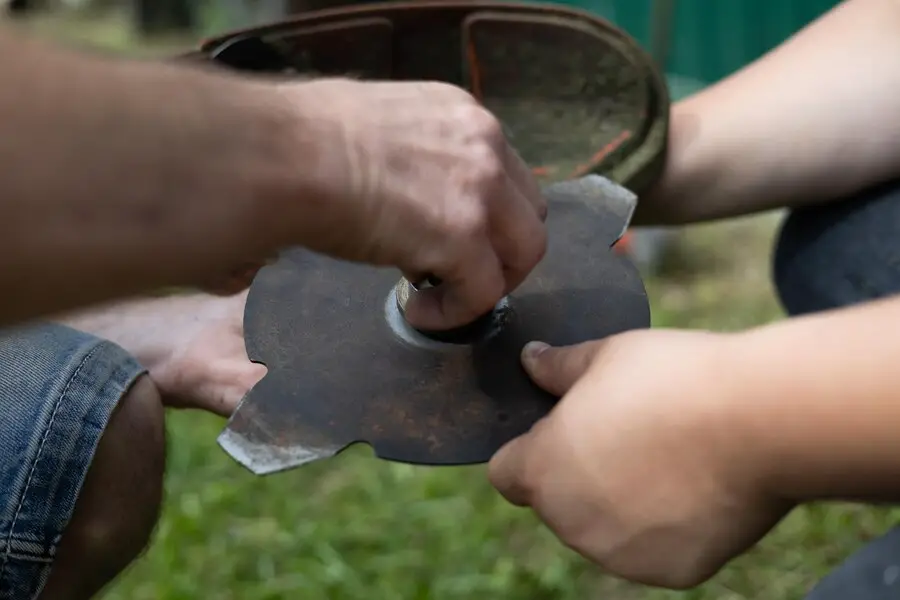
Introduction
A well-maintained lawn mower is key to a well-kept lawn, and one of the easiest ways to ensure a perfect cut is to keep the blades sharp. When lawn mower blades are dull, they rip the grass instead of cutting it cleanly, which can lead to brown tips and an unhealthy lawn. Sharpening the blades at home is a simple and cost-effective way to keep your mower running smoothly, and it can save you a trip to the repair shop.
Tools and Materials Needed
Before you begin, gather the necessary tools and materials for the job. Having everything on hand will help the process go smoothly and prevent unnecessary interruptions. Here’s what you’ll need:
- Socket wrench or blade removal tool (for removing the blade)
- A metal file or sharpening stone (for manual sharpening)
- Angle grinder or bench grinder (for power sharpening)
- Pliers (for holding the blade)
- Safety gloves (to protect your hands)
- Safety goggles (to protect your eyes)
- A vice or clamp (to hold the blade steady while sharpening)
Step 1: Safety First
When it comes to sharpening lawn mower blades, safety is paramount. The tools involved can be dangerous if not used properly, so take the necessary precautions to avoid injury.
Safety Tips:
- Always disconnect the spark plug before working on your lawn mower to prevent it from accidentally starting.
- Wear gloves to protect your hands from sharp edges.
- Goggles are a must to protect your eyes from flying debris.
- Ensure your workspace is well-lit and free of distractions.
Step 2: Remove the Lawn Mower Blade
Now that you’re geared up and ready to go, it’s time to remove the blade. Most mowers have a bolt securing the blade to the spindle, so you’ll need the right tools to loosen it.
How to Safely Remove the Blade:
- Use a socket wrench to loosen the bolt securing the blade.
- If the bolt is rusted or difficult to remove, spray it with a rust remover and wait a few minutes.
- Once loosened, carefully remove the blade. Be cautious, as it may be heavy or difficult to maneuver.
Step 3: Clean the Blade
Once the blade is off, you’ll want to clean it thoroughly. Dirt, grass clippings, and other debris can dull the blade and make sharpening less effective.
Cleaning Techniques:
- Use a wire brush to scrub off any large clumps of dirt.
- Rinse the blade with water to remove smaller debris.
- For tough grime, consider using a degreaser and a rag to wipe it down.
Step 4: Inspect the Blade
Before jumping into sharpening, take a moment to inspect the blade for any signs of damage. A cracked or bent blade will need to be replaced rather than sharpened.
What to Look For:
- Cracks or chips on the blade
- Bent edges that affect its performance
- Rust that might compromise the metal’s integrity
If you notice any damage, it’s better to replace the blade than risk using a compromised one.
Step 5: Sharpening the Blade
Now comes the fun part—sharpening! There are two common methods: manual sharpening and using a power tool.
Manual Sharpening Method:
- Secure the blade in a vice or clamp to keep it steady.
- Using a metal file or sharpening stone, carefully work the edge of the blade at a 45-degree angle.
- Move in one direction, following the original bevel, to avoid damaging the edge.
Using a Power Tool:
- If you’re using an angle grinder or bench grinder, make sure to maintain the same angle (usually 30 to 45 degrees).
- Lightly touch the blade to the grinder, making small passes to avoid overheating the blade.
- Be patient and avoid rushing the process to ensure a sharp and even edge.
Step 6: Reinstall the Blade
Once your blade is sharp and clean, it’s time to put it back on the mower. Ensure that it’s installed securely to avoid accidents.
How to Reinstall the Blade:
- Place the blade back on the spindle and align it correctly.
- Tighten the bolt securely, making sure the blade is firmly in place.
- Double-check that the blade is properly aligned with the mower’s body.
Step 7: Test the Mower
Before you head out to mow the lawn, it’s important to test whether the blade is sharp enough.
Testing Tips:
- Start the mower and check for smooth operation.
- If the blade still struggles to cut or leaves ragged edges, it may need further sharpening.
- Adjust the mower settings if necessary for optimal cutting height.
Tips for Maintaining Sharp Blades
Keeping your lawn mower blades sharp doesn’t stop at one sharpening session. Regular maintenance will extend the life of your blades and improve mower performance.
Maintenance Tips:
- Clean the blade after each use to prevent buildup.
- Sharpen the blade at least once or twice a season.
- Store your mower in a dry place to prevent rust.
Common Mistakes to Avoid
When sharpening lawn mower blades, it’s easy to make mistakes. Here are some common pitfalls to avoid:
- Overheating the blade: This can weaken the metal and reduce its sharpness.
- Not maintaining the right angle: Sharpening at the wrong angle can lead to an uneven cut.
- Ignoring safety: Never attempt sharpening without proper safety gear.
Conclusion
Sharpening your lawn mower blades at home is a rewarding and straightforward task that can make a significant difference in your lawn’s appearance. With the right tools, safety precautions, and a little patience, you can easily maintain sharp blades and enjoy a healthier, more beautiful lawn. Don’t wait for your mower to struggle—take action and sharpen those blades today!
FAQs
- How often should I sharpen my lawn mower blades? It’s recommended to sharpen your lawn mower blades at least once or twice a season, depending on how often you mow.
- Can I sharpen my lawn mower blades with a file? Yes, you can manually sharpen the blade with a metal file, but it requires patience and attention to detail.
- What if my lawn mower blade is bent? If the blade is bent, it’s best to replace it rather than attempting to sharpen it.
- Is it safe to use a power tool for sharpening? Yes, power tools like an angle grinder are effective for sharpening, but you must maintain the proper angle and avoid overheating the blade.
- Can I reuse my lawn mower blades? As long as the blade is not cracked or damaged, you can continue using it after sharpening.



